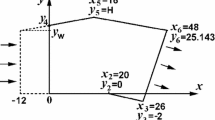Abstract
The linear problem of the stability of Poiseuille flow between two infinite plates rotating about an axis parallel to the plates and normal to the flow direction was studied in [1, 2]. It was established that the flow is least stable with respect to disturbances in the form of standing waves known as Taylor eddies. The experimental data of [1, 3] and the results [4] of a numerical integration of the Navier-Stokes equations for channels with cross sections highly elongated in the direction of the axis of rotation are in good agreement with the conclusions of the linear theory. In the case of channels with a side ratio of the order of unity, which is of greater practical interest, the primary flow becomes essentially three-dimensional and evolves with variation of the governing criteria: the Reynolds and Rossby numbers. Obviously, this seriously complicates the use of the methods of the linear theory. The effect of the ratio of the sides of the cross section on the stability of the primary flow regime was studied experimentally in [3]. The present article describes the results of an investigation of the problem based on a numerical method of integrating the nonlinear Navier-Stokes equations. Moreover, an asymptotic estimate of the stability limit of the primary regime, based on a local condition of inviscid instability of rotating flows, is presented.
Similar content being viewed by others
Literature cited
J. E. Hart, “Instability and secondary motion in a rotating channel flow,” J. Fluid Mech.,45, 341 (1971).
D. K. Lezius, “Finite-difference solutions of Taylor instabilities in viscous plane flow,” Comput. Fluids,3, 103 (1975).
A. V. Kuz'minskii, E. M. Smirnov, and S. V. Yurkln, “Longitudinally oriented cellular structures of the Taylor—Görtler eddy type on the elevated pressure side of rotating channels,” Zh. Prikl. Mekh. Tekh. Fiz., No. 6, 129 (1983).
C. G. Speziale and S. Thangam, “Numerical study of secondary flows and roll-cell instabilities in rotating channel flow,” J. Fluid Mech.,130, 377 (1983).
S. B. Koleshko, “Difference scheme for solving steady viscous flow equations,” in: Numerical Methods of Continuum Mechanics, Vol. 10 [in Russian], Novosibirsk (1979), pp. 100–104.
E. M. Smirnov and S. V. Yurkin, “Flow in a rotating square duct,” Izv. Akad. Nauk SSSR, Mekh. Zhidk. Gaza, No. 6, 24 (1983).
R. Schilling and H. Marcinowski, “Untersuchung des Druckverlustes und der Wariaeüber-ganges in rotierenden Kanälen mit rechteckigem Querschnitt,” in: Recent Developments in Theoretical and Experimental Fluid Mechanics, Springer, Berlin (1979), pp. 529–545.
C. G. Speziale, “Numerical study of viscous flow in rotating rectangular ducts,” J. Fluid Mech.,122, 251 (1982).
V. K. Shchukin, Heat Transfer and Hydrodynamics of Internal Flows in Body Force Fields [in Russian], Mashinostroenie, Moscow (1980).
E. Döbner, “Über den Strömungswiderstand in einem rotierenden Kanal,” Dissertation, Technische Hochschule Darmstadt, Darmstadt (1959).
M. Piesche and K.-O. Felsch, “Experimental investigation of pressure loss in rotating curved rectangular channels,” Arch. Mech., Warsaw,32, 747 (1980).
A. V. Kuz'minskii, E. M. Smirnov, and S. V. Yurkin, “Experimental investigation of the developing flow in a square duct rotating about the transverse axis,” Inzh.-Fiz. Zh.,45, 662 (1983).
E. M. Smirnov, “Asymptotic expression's for the resistance of rapidly rotating radial rectangular channels,” Izv. Akad. Nauk SSSR, Mekh. Zhidk. Gaza, No. 6, 42 (1978).
D. K. Lezius and J. P. Johnston, “Roll-cell instabilities in rotating laminar and turbulent channel flows,” J. Fluid Mech.,77, 153 (1976).
Author information
Authors and Affiliations
Additional information
Translated from Izvestiya Akademii Nauk SSSR, Mekhanika Zhidkosti i Gaza, No. 5, pp. 27–32, September–October, 1985.
Rights and permissions
About this article
Cite this article
Smirnov, E.M. Bifurcation of developed flow in rectangular channels rotating about the transverse axis. Fluid Dyn 20, 685–690 (1985). https://doi.org/10.1007/BF01050079
Received:
Issue Date:
DOI: https://doi.org/10.1007/BF01050079




